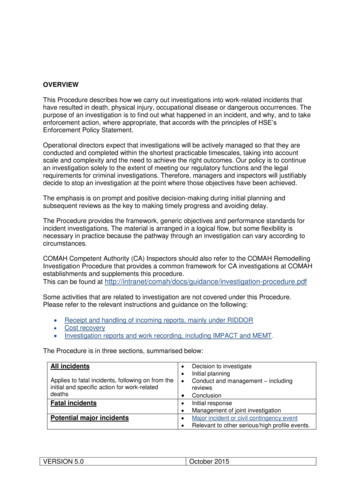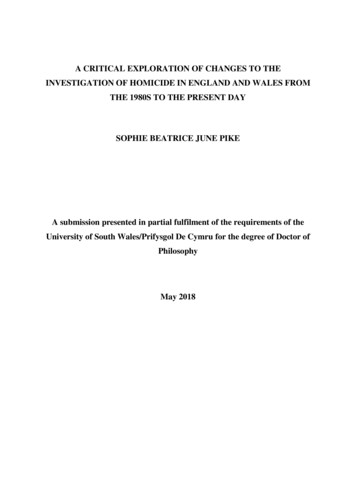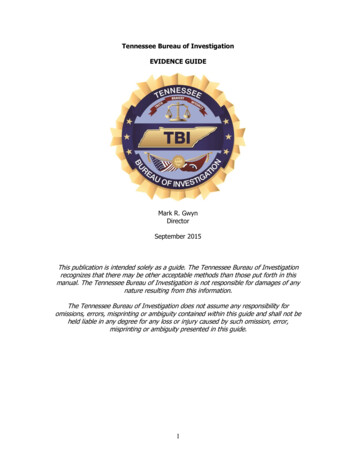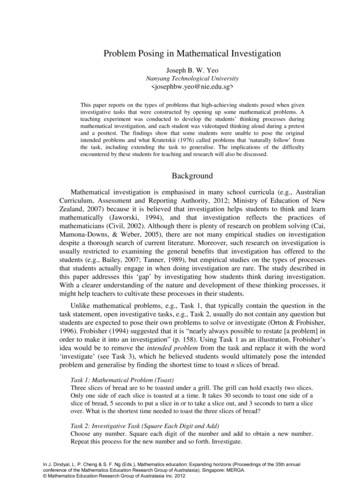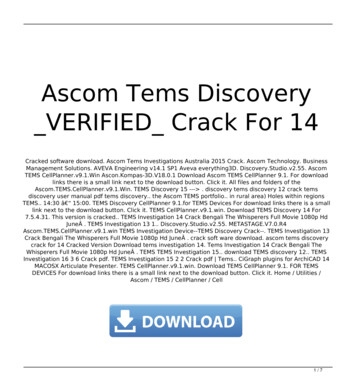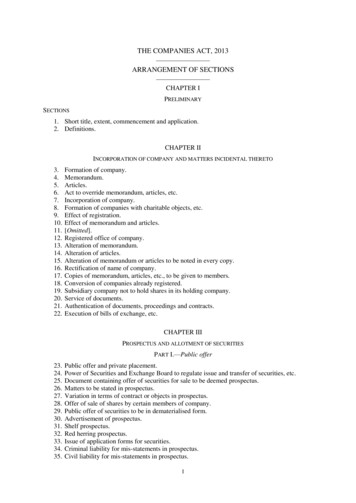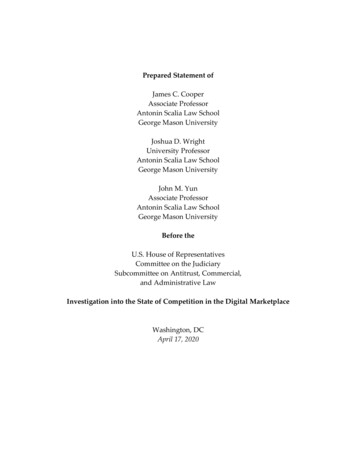
Transcription
Prepared Statement ofJames C. CooperAssociate ProfessorAntonin Scalia Law SchoolGeorge Mason UniversityJoshua D. WrightUniversity ProfessorAntonin Scalia Law SchoolGeorge Mason UniversityJohn M. YunAssociate ProfessorAntonin Scalia Law SchoolGeorge Mason UniversityBefore theU.S. House of RepresentativesCommittee on the JudiciarySubcommittee on Antitrust, Commercial,and Administrative LawInvestigation into the State of Competition in the Digital MarketplaceWashington, DCApril 17, 2020
INTRODUCTIONChairman Cicilline, Ranking Member Sensenbrenner, and Members of theSubcommittee, thank you for offering us the opportunity to submit our writtentestimony on key antitrust questions involving the digital economy.1The extraordinary success of the digital sector of the domestic economy isindisputable. Digital platforms represent the top companies traded on the United Statesstock market, with trillions of dollars in aggregate market capitalization.2 With this levelof market success, growth, and influence, both economically and culturally, it isperhaps inevitable that these businesses are increasingly in the forefront of public policydiscussions. Most relevant for our purposes are the now-common claims that thesefirms have systematically engaged in anticompetitive conduct, or are otherwiseinsulated from competitive forces, and that digital platforms’ exercise of monopolyIn this comment, we rely upon the prior work of the Global Antitrust Institute (GAI) on these topics. See,e.g., GAI Comment on The Federal Trade Commission’s Hearings on Competition and ConsumerProtection in the 21st Century, The Consumer Welfare Standard in Antitrust Law; GAI Comment on TheFederal Trade Commission’s Hearings on Competition and Consumer Protection in the 21st Century,Vertical Mergers; the GAI Comment on The Federal Trade Commission’s Hearings on Competition andConsumer Protection in the 21st Century, Platforms. We also rely on the Prepared Statement of John M.Yun Before the United States Senate, Committee on the Judiciary, Subcommittee on Antitrust,Competition Policy, and Consumer Rights, Hearing on “Competition in Digital Technology Markets:Examining Acquisitions of Nascent or Potential Competitors by Digital Platforms,” September 24, 2019.We thank Scalia Law student Ethan Hoffman for invaluable research assistance.2 The term “platforms” (a.k.a. multisided or two-sided markets) describes firms that have developed asystem or network where more than one group (e.g., users, merchants, advertisers) all participate in orderto engage in mutually beneficial exchange. While there is no universal definition, Professors AndreiHagiu and Julian Wright offer a good starting point: Platforms “enable direct interactions between” twoor more groups where each group is “affiliated with the platform” in some manner—typically throughplatform-specific investments. See Andrei Hagiu & Julian Wright, Multi-Sided Platforms, 43 INT’L J. INDUS.ORG. 162, 163 (2015). Regardless of the precise definition, platforms are principally characterized by crossgroup effects, or indirect network effects. These effects occur when the size of one group creates apositive externality on one or more of the other groups on the platform, which, in turn, attracts them tothe platform. Some platforms also have direct network effects, which occur when the increase in the sizeof a given group confers additional benefits to other members of the same group, e.g., telephone systems,fax machines, email, and social media.11
power has remained unchecked at least in part due to gaps in our antitrust laws or laxenforcement of existing laws.We are pleased to provide our views on three important questions concerningthe state of competition in the digital marketplace: (1) Are existing antitrust laws thatprohibit monopolization and monopolistic conduct adequate for digital platforms?; (2)Are existing laws adequate to prohibit anticompetitive transactions including forvertical and conglomerate mergers, serial acquisitions, data acquisitions, or acquisitionsof potential competitors?; and (3) Is the institutional structure of antitrustenforcement—including the current levels of appropriations to the antitrust agencies,existing agency authorities, congressional oversight of enforcement, and currentstatutes and case law—adequate to promote the robust enforcement of the antitrustlaws?We believe that the most direct answer to each of these questions is: “Yes.” Theantitrust laws have a rich history, characterized by their flexibility and ability to adaptover time to changes in the structure of the economy, business models, and consumerpreferences from the passage of the Sherman Act in the late 19th century to today.3 Themodern consumer welfare standard continues to provide a sound and stable intellectualfoundation to guide the enforcement of the antitrust laws. Therefore, the current bodyof doctrine regarding monopolization is sufficient to address the digital marketplace.Further, we believe the existing antitrust laws are more than adequate to address bothSee, e.g., Joshua D. Wright et al., Requiem for a Paradox: The Dubious Rise and Inevitable Fall of HipsterAntitrust, 51 ARIZONA STATE L.J. 293, 293 (2019) (“Over the last fifty years, antitrust has developed into acoherent, principled, and workable body of law that contributes positively not only to Americancompetitiveness and societal well-being, but also helps to export the culture of market competitionaround the world.”); Joshua D. Wright & Douglas H. Ginsburg, The Goals of Antitrust: Welfare TrumpsChoice, 81 FORDHAM L. REV. 2405, 2405–06 (2013) (describing the “promotion of economic welfare as thelodestar of antitrust laws” which “restored intellectual coherence to a body of law Robert Bork hadfamously described as paradoxical”).32
vertical mergers and the acquisition of nascent and potential competitors—two subjectscommonly discussed as potential gaps in antitrust enforcement.Finally, we find that the institutional structure of antitrust enforcement isgenerally sound, and consequently, we do not recommend any sweeping structuralchanges. For example, we do not believe that adding additional operating unitscomprising non-antitrust specialists (e.g., a “technology group”) is warranted.Nonetheless, we do recommend some changes within the existing institutional structurethat we believe would improve capabilities and transparency. Specifically, we believethat Congress should (1) expand the size and role of Ph.D. economists at both agencies;(2) eliminate the FTC Act’s common carrier and non-profit exemptions; (3) formalizeclearance agreements between the agencies to provide parties more transparency onwhich agency is likely to handle a merger or conduct an investigation; and (4)potentially consider dividing enforcement responsibilities between the two agencies toavoid duplication and allow for gains from specialization.I.THE CONSUMER WELFARE STANDARDAs a threshold matter, we want to lay out what we believe should be the metricfor assessing the state of competition in the digital market place: the consumer welfarestandard, which is the guiding principle of modern antitrust enforcement.4 Theconsumer welfare standard is often misunderstood as a liability standard in individualcases that requires antitrust plaintiffs to demonstrate with precision that harm toconsumers arising from the challenged conduct outweighs its benefits. That is incorrect.The consumer welfare standard specifies the objective of antitrust institutions. Itdemands that substantive and procedural antitrust rules be fashioned to benefitSee The Consumer Welfare Standard in Antitrust: Outdated or a Harbor in a Sea of Doubt?: Hearing Before theSubcomm. on Antitrust, Competition Policy and Consumer Protection of the S. Comm. on the Judiciary, 115thCong. (2017) (statement of Joshua D. Wright).43
consumers, adopting economic learning and accounting for error costs.5 This does notmean that the antitrust agencies or private plaintiffs must prove that actual harmsoutweigh actual benefits in every case. Rather, courts employ economic theory andjudicial experience to create presumptions and procedural rules to truncate the analysiswhere appropriate to minimize error costs and administrative costs.6These presumptions favor plaintiffs when the type of conduct at issue is likely toharm consumers; when the type of conduct at issue is likely to have a beneficial orneutral effect on consumers, the presumptions favor defendants. For example, in casesinvolving conduct that is known to “always or almost always” reduce market output orraise market prices to consumers, the rule of per se illegality applies, and there is noneed to prove harm.7 This approach facilitates the prosecution of truly harmful conduct,while reducing costs associated with false positives.8The consumer welfare standard has been widely lauded for bringing coherenceand credibility to antitrust law, providing a framework for consistent, economicallysound decision-making, and giving consumers the benefit of lower prices, increasedoutput, higher product quality, and more innovation.9 By focusing on a single objectivemeasure, the consumer welfare standard disciplines modern antitrust law. Antitrustenforcers and courts under a consumer welfare standard are forced to support theirSee Frank H. Easterbrook, The Limits of Antitrust, 63 TEX. L. REV. 1 (1984).See, e.g., Joshua D. Wright, Abandoning Antitrust’s Chicago Obsession: The Case for Evidence-Based Antitrust,78 ANTITRUST L.J. 241, 247–49 (2012) (describing the error-cost framework).7 See, e.g., Broadcast Music, Inc. v. Columbia Broad. Sys., Inc., 441 U.S. 1, 19–20 (1979); Nat’l Soc’y of Prof’lEng’rs v. United States, 435 U.S. 679 (1978); see also Andrew I. Gavil, Burden of Proof in U.S. Antitrust Law,in 1 ISSUES IN COMPETITION LAW AND POLICY 125, 138 (ABA Section of Antitrust Law 2008) (“For casesfalling under the per se rule, plaintiffs needed only to establish concerted action of a kind that fell withinone of the recognized per se categories, like price fixing, division of markets, or certain group boycotts.The courts would then presume that such conduct had the requisite unreasonable anticompetitive effect.In evidentiary terms, the per se rule created an irrebuttable presumption of unreasonableness.”).8 See Easterbrook, supra note 5, at 14–17.9 See, e.g., Wright, supra note 4, at 5–9; Wright & Ginsburg, supra note 3, at 2406 n. 12 (collecting supportfor the statement that “there is now widespread agreement that th[e] evolution toward welfare and awayfrom noneconomic considerations has benefitted consumers and the economy more broadly.”).564
actions with sound economic evidence. This helps to deter arbitrary or politicallymotivated enforcement actions that would chill aggressive, but beneficial, competitiveconduct.10 Most importantly, the standard helps consumers, which is to say, allAmericans.Antitrust was not always based upon such a clear vision.11 Prior to the economicrevolution in antitrust law, which took hold in the late 1970s, courts applied theSherman and Clayton Acts incoherently, condemning low prices and protecting lessefficient, but politically-favored firms from competition.12 Abandoning the consumerwelfare standard inevitably would harm consumers, lower output, diminish quality,and decrease innovation. The question for proponents of alternative standards is whatoffsetting benefits, if any, American consumers would receive in exchange for a shift toa standard that unequivocally makes them poorer. We believe the answer is either zeroor close to it, and certainly not sufficient to justify the harm done to consumers byabandoning the consumer welfare standard.In sum, the consumer welfare standard remains the proper antitrust standard toprotect the competitive process and, therefore benefit, consumers.13 It also has theSee Elyse Dorsey, Jan Rybnicek, & Joshua D. Wright, Hipster Antitrust Meets Public Choice Economics: TheConsumer Welfare Standard, Rule of Law, and Rent-Seeking, ANTITRUST CHRON., Apr. 2018, at t.pdf.11 See generally William E. Kovacic & Carl Shapiro, Antitrust Policy: A Century of Economic and LegalThinking, 14 J. ECON. PERSP. 43 (2000).12 See Utah Pie Co. v. Cont'l Baking Co., 386 U.S. 685 (1967) (condemning rivals’ attempts to compete withUtah Pie by lowering prices); Brown Shoe Co. v. United States, 370 U.S. 294, 344 (1962) (“[W]e cannot failto recognize Congress' desire to promote competition through the protection of viable, small, locallyowned businesses. Congress appreciated that occasional higher costs and prices might result from themaintenance of fragmented industries and markets. It resolved these competing considerations in favorof decentralization.”); United States v. Trans-Mo. Freight Ass'n, 166 U.S. 290, 323 (1897) (antitrust lawexists to protect “small dealers and worthy men”); see also Douglas H. Ginsburg, Originalism and EconomicAnalysis: Two Case Studies of Consistency and Coherence in Supreme Court Decision Making, 33 HARV. J.L. &PUB. POL'Y 217, 217–18 (2010) (discussing the assortment of vague and anti-competitive social andpolitical goals that the Court had read into the Sherman Act).13 See, e.g., Wright et al., supra note 3, at 353 (“Critically, the consumer welfare standard allows antitrust tofunnel earlier questions about the ability of less efficient rivals to compete, the viability of small and105
added benefit of allowing antitrust analysis to evolve alongside developments ineconomics to address new types of business models and emerging industries.14 Whatthe critics propose is a reversion to the empirically discredited approach to antitrust inwhich size, superior efficiency, or innovation could create liability. Abandoning theconsumer welfare standard in favor of the arbitrary and unworkable standardsproposed by its critics will not solve any actual competitive problem, but rather willharm competition and consumers. We also do not believe that proposals to “expand” orto effectively abandon the consumer welfare standard to incorporate other objectivesbeyond those that impact the efficiency of a particular market (namely, price, quantity,quality, and innovation) are beneficial. For all the above reasons, we do not recommendnor support proposals to modify, supplement, or replace the consumer welfarestandard with alternative objectives.II.MONOPOLIZATIONWe believe that, as currently interpreted by the courts and employed by theantitrust agencies, the Sherman Act’s prohibition of monopolization is adequate to thetask of preserving competition in the digital marketplace. Monopolization law hasevolved to balance the real threats to consumers from the accrual of monopoly powerthrough means other than “competition on the merits,” and the harms that consumersalso suffer when firms pull their competitive punches for fear of antitrust liability andtreble damages. For example, by not condemning the “[T]he mere possession ofindependent competitors, and the size and influence of firms back to a singular inquiry about whetherconsumers are harmed.”).14 See, e.g., Ohio v. Am. Express Co., 138 S. Ct. 2274 (2018). Ohio v. American Express Co. illustrates howantitrust jurisprudence is able to adapt to advances in economic research. The Court provided guidanceon proper rule of reason antitrust analysis of multisided platforms. Specifically, the Court adopted an“integrated” approach to defining relevant product markets and assessing competitive effects andrequired consideration of all sides in a plaintiff’s prima facie case in a burden-shifting scheme. While thedecision has attracted some debate with regard to the specific presumptions and burdens of productionthat will be applied, there is a broad and bipartisan consensus that the appropriate standard is consumerwelfare.6
monopoly power, and the concomitant charging of monopoly prices,” Section 2preserves incentives to compete and innovate. As the Supreme Court explains:The opportunity to charge monopoly prices-at least for a short period-is whatattracts “business acumen” in the first place; it induces risk taking that producesinnovation and economic growth. To safeguard the incentive to innovate, thepossession of monopoly power will not be found unlawful unless it isaccompanied by an element of anticompetitive conduct.15Further, we believe that the current monopolization law, as a general matter,provides a good balance of reducing both false positives (Type I errors) and falsenegatives (Type II errors). For example, in Microsoft, the DOJ was able to provesuccessfully that Microsoft violated Section 2 of the Sherman Act when, inter alia, itemployed anticompetitive means to maintain its monopoly in operating systems.16More recently, and without endorsing the merits of any particular case, the agencieshave had success in bringing monopolization cases. For example, the plaintiffs haveprevailed in McWane, Dentsply, and Qualcomm.17 Additionally, there was a settlementbetween the FTC and Intel based on monopolization allegations.18 In private litigation,for instance, Meritor successfully brought a Section 2 claim against Eaton Corp.19Below, we address some suggestions to expand the reach of the currentmonopolization standards—namely, suggestions to import the European Union’sconcept of “abuse of dominance;” to have stronger presumptions of harm for largeVerizon Commc'ns Inc. v. Law Offices of Curtis V. Trinko, LLP, 540 U.S. 398, 407 (2004).U.S. v. Microsoft Corp., 253 F.3d 65 (D.C. Cir. 2001).17 McWane, Inc. v. F.T.C., 783 F.3d 814 (11th Cir. 2015); U.S. v. Dentsply Intern., Inc., 399 F.3d 181 (3rd Cir.2005) (finding a Section 2 violation); F.T.C. v. Qualcomm, Case No. 17-CV-00220-LHK. Note thatCommissioner Joshua D. Wright dissented in McWane. See Dissenting Statement of Commissioner JoshuaD. Wright—In the Matter of McWane, Inc., a Corporation, and Star Pipe Products, Ltd., February 6, matter-mcwane-inc.18 See ainst-intel.19 ZF Meritor, LLC v. Eaton Corp., 696 F.3d 254 (3rd Cir. 2012).15167
digital platforms “self-preferencing” their own content; and to use the antitrust laws toaddress issues surrounding consumer data privacy.A.Importing Abuse of DominanceSome commentators have argued that in light of prevailing interpretations, U.S.antitrust law should consider importing the European concept of “abuse of dominance”in order to have a means of prosecuting online platforms for conduct outside of thescope of the Sherman Act.20 The European approach to abuse of dominance applies apresumption of illegality to a monopolist’s conduct if it has the potential or capability toharm competition; places special obligations to prevent dominant firms from raising“artificial” barriers to entry; and explicitly has an objective to also protect rivals.21 Ineffect, this approach renders unlawful conduct that harms rivals even without a robustdemonstration of harm to competition or consumers. It operates based uponpresumptions that self-preferencing, vertical integration, and other vertical conductharms competition rather than requiring a demonstration. For instance, under thisapproach, firms with large market shares can incur liability for refusing to grant rivalsaccess to their facilities or to share their intellectual property with them.22Assuming a “dominant” firm came by its large market share lawfully, adoptingthe theory of abuse of dominance is nothing less perverse than creating liability forcompetitive success. The antitrust laws were passed to protect the competitive process,See Lina Khan & Sandeep Vaheesan, Market Power and Inequality: The Antitrust Counterrevolution and ItsDiscontents, 11 HARV. L. & POL'Y REV. 235, 283 (2017) (“The antitrust agencies and courts should look toEuropean Union abuse of dominance law for a model to emulate. . . Dominant firms can engage in certaintypes of conduct only if they have credible business reasons for doing so.”); see also Eleanor M. Fox,Platforms, Power, and the Antitrust Challenge: A Modest Proposal to Narrow the U.S.-Europe Divide, 98 NEB. L.REV. 297, 315 (2019) (arguing that “[i]t is time for the United States to stop the big data antitrust abuses”therefore “the United States might wish to take Europe's big data initiatives more seriously.”).21 See Khan & Vaheesan, supra note 20.22 See Case C-418/01, IMS Health GmbH & Co. OHG v. NDC Health GmbH & Co. KG, 2004 E.C.R. I-5039(Eur. Ct. Justice) (requiring a firm to license data to its competitors).208
not less efficient competitors.23 The theory of abuse of dominance does precisely theopposite: It penalizes successful firms for being successful. By burdening successfulfirms with the duty to treat their rivals with something less than full competitive zeal,the abuse of dominance theory stifles successful firms’ incentives to innovate and tocompete with their rivals.24 That is precisely why the Supreme Court has refused toembrace the “essential facilities” doctrine, and has made clear that a dominant firm hasno general duty to aid its rivals.25B.Self-PreferencingSome commentators have also suggested that “self-preferencing” by onlinemerchants raises antitrust issues.26 For example, some have contended that Amazonwould run afoul of Section 2 of the Sherman Act if it were to compete as a merchant inits online marketplace, as it can use other merchants’ sales data to identify and copysuccessful products.27The notion that the antitrust laws should condemn a large digital platform fromfavoring its own content or products over those of rival suppliers has a degree ofsuperficial appeal. This legal theory is based upon the idea that the platform is both a“host” as well as competitor, which is perceived as a conflict of interest with negativeSee Brunswick Corp. v. Pueblo Bowl-O-Mat, Inc., 429 U.S. 477, 488 (1977).See, e.g., Joined Cases C-241 & C-242/91 P, Radio Telefis Eireann v. Comm'n of the Eur. Cmtys., 1995E.C.R. 1-743 (requiring a television station operator to provide a third-party publisher with its broadcastschedule for inclusion in a weekly television guide, a product which did not yet exist on the market whenthe case was filed).25 See Pac. Bell Tel. Co. v. Linkline Commc'ns, Inc., 555 U.S. 438, 450 (2009) (“[I]f a firm has no antitrustduty to deal with its competitors at wholesale, it certainly has no duty to deal under terms and conditionsthat the rivals find commercially advantageous.”); Trinko, 540 U.S. at 411 (“[W]e do not believe thattraditional antitrust principles justify adding the present case to the few existing exceptions from theproposition that there is no duty to aid competitors.”).26 Examples include Google integrating its own vertical search properties, such as local reviews and maps,with its general search results and Amazon promoting its own private label brands over those from thirdparty merchants.27 See, e.g., Lina M. Khan, Amazon’s Antitrust Paradox, 126 YALE L.J. 710, 780–83, 799 (2017).23249
implications for competition. Yet, observing a dominant platform taking actions thatdisadvantage a rival does not answer the core question in any antitrust inquiry: doesthe conduct at issue, in this case self-preferencing, harm consumers rather than justrivals.28 This necessarily follows given that harm to rivals is consistent with bothvigorous, procompetitive behavior and anticompetitive conduct. Thus, policies thatoverly favor competitors over competition is contrary to the antitrust laws and tooverall economic efficiency.29Rather, the purpose of the federal antitrust laws is to safeguard the competitiveprocess—not to dictate market outcomes or to protect rivals. Certainly, private labelentry and self-preferencing can, under certain circumstances, serve as a basis for anantitrust violation if the entry has no procompetitive justification and is primarilyintended to impair the competitive process. This is the theory of harm that wasadvanced in U.S. v. Microsoft and is a plausible and viable theory.30Recently, the U.S. agencies have examined this question in the context of digitalplatforms. Specifically, the FTC engaged in a two-year investigation into whetherGoogle’s practice of promoting its own “vertical search” results (e.g., maps, shoppingitems with prices, listing of local restaurants with reviews) within its “horizontalsearch” results page (i.e., the standard “blue links” associated with general searchengines) caused harm to consumers.31 Yet, in 2013, the FTC closed its investigationstating that “quantitative evidence the Commission examined are largely consistentSee Brunswick Corp. v. Pueblo Bowl-O-Mat, Inc., 429 U.S. 477, 489 (1977).See Trinko, 540 U.S. at 407–08 (“Firms may acquire monopoly power by establishing an infrastructurethat renders them uniquely suited to serve their customers. Compelling such firms to share the source oftheir advantage is in some tension with the underlying purpose of antitrust law, since it may lessen theincentive for the monopolist, the rival, or both to invest in those economically beneficial facilities.”).30 U.S. v. Microsoft Corp., 253 F.3d 65 (D.C. Cir. 2001) (“Judicial deference to product innovation,however, does not mean that a monopolist's product design decisions are per se lawful.”).31 See, e.g., Michael A. Salinger & Robert J. Levinson, Economics and the FTC’s Google Investigation, 46 REV.INDUS. ORG. 25 (2015); John M. Yun, Understanding Google’s Search Platform and the Implications for AntitrustAnalyses, 14 J. COMPETITION L. & ECON. 311 (2018).282910
with the conclusion that Google likely benefited consumers by prominently displayingits vertical content on its search results page.”32 We believe the Commission correctlyweighed the procompetitive benefits to consumers against potential negative effects oncompetition, using the best evidence and economic analysis available, in closing itsinvestigation without action.In sum, a monopolization theory based on self-preferencing is a theory that tendsto create liability for competition itself. After all, imitating a successful competitor isamong the most common forms of competition. Restricting successful companies fromentering new markets—without a careful examination of the facts—can only serve todiminish competition (and its attendant advantages of lower prices, greater output, andincreased consumer welfare).C.Employing Antitrust Laws to Deal with Consumer Data PrivacySome commentators have suggested that platforms that provide ostensibly freeservices to consumers exercise their monopoly power through collecting increasingamounts of personal data.33 Although privacy practices by themselves are beyond thescope of the antitrust laws, diminished competition could affect firms’ data practices inFed. Trade Comm'n, Statement Regarding Google's Search Practices, In re Google Inc., FTC File No. 1110163, at 2 (Jan. 3, ublic .33 See, e.g., John M. Newman, The Myth of Free, 86 GEO. L. REV. (2017); Dina Srinivasan, The Antitrust CaseAgainst Facebook: A Monopolist’s Journal Towards Pervasive Surveillance in Spite of Consumers’ Preference forPrivacy, 16 BERKELEY BUS. L.J. 39 (2019). The recent case against Facebook brought by theBundeskartellamt (the German competition authority) rests on this theory. In particular, it suggests thatFacebook’s dominant position allows it to extract concessions from consumers that allow Facebook tocollect data about their actions outside of the Facebook platform. These data, in turn, help entrenchFacebook’s dominant position via network effects. See Bundeskartellamt, Feb. 5, 2019, ht/2019/B6-22-16.pdf? blob publicationFile&v 5 . This case was overturned on appeal. OLG [DüsseldorfHigher Regional Court], Aug. 26, 2019, VI-Kart 1/19 (V), archiv/Pressemitteilungen aus 2019/20190826 PM Facebook/20190826-Beschluss-VI-Kart-1-19- V .pdf.3211
a way that negatively impacts consumers and potentially raise antitrust concerns. Forexample, holding the price and all other attributes of a product constant, an onlineplatform’s quality could be said to decrease as the level of privacy it provides falls. Thatis, lower levels of privacy offered by a platform could be said to raise its qualityadjusted price. Although it is theoretically possible to position a reduction in privacy ascompetitive harm in an antitrust analysis, there are several potential complications.First, even if one were to take the analogy between consumer data and price orquality at face value, as a threshold matter, unilateral pricing and quality decisions by amonopolist without some accompanying anticompetitive behavior are not actionableunder U.S. antitrust laws.34 This rationale behind this rule is sound: allowing courts andagencies to second-guess pricing and quality decisions of firms would convert antitrustfrom an ex post enforcement regime into an ex ante regulatory regime. What is more, itwould inject an untenable amount of subjectivity into enforcement decisions; givenheterogenous preferences for privacy, what may be serious reduction in privacy to oneregulator or judge may represent a consumer benefit to another.35 The regulatoryuncertainty that accompanies subjectivity can lead firms to pull their competitivepunches for fear of antitrust liability and accompanying treble damages.36Second, it is unclear how important privacy is as a dimension of competition. It iswell-documented that although consumers state a strong preference for privacy,See Trinko, 540 U.S. at 407–08
9 See, e.g., Wright, supra note 4, at 5-9; Wright & Ginsburg, supra note 3, at 2406 n. 12 (collecting support for the statement that "there is now widespread agreement that th[e] evolution toward welfare and away from noneconomic considerations has benefitted consumers and the economy more broadly.").





